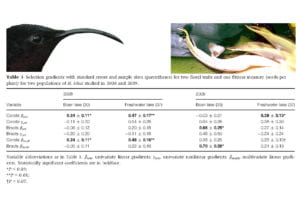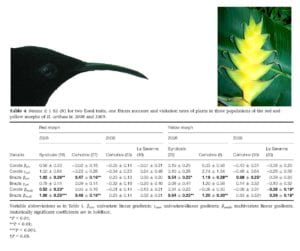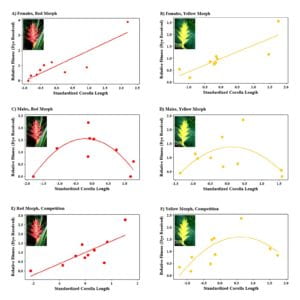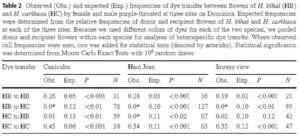Pollinator-mediated Selection on Floral Traits
The close correspondence betweeen the bills, body sizes, and energy requirements of male and female purple-throated caribs to the corolla lengths, bract numbers, and energy rewards of their Heliconia food plants suggest that the birds have had a major role in the evolution of floral traits in H. bihai and H. caribaea. We evaluated the strength and direction of natural selection on corolla length and number of bracts per inflorescence in allopatric populations of H. bihai and H. caribaea for five populations on the island of Dominica, West Indies, over a two-year period by relating seed production to floral traits. In H. bihai, directional selection for longer corollas was always significant with the exception of one population in one year, whereas selection on bract numbers was rare and found only in one population in one year (see below).

In contrast, significant directional selection for more bracts per inflorescence occurred in all three populations of the yellow morph and in two populations of the red morph of H. caribaea, whereas significant direction selection on corolla length occurred in only one population of the red morph and one population of the yellow morph (see below).

Selection for longer corollas in H. bihai may result from better mechanical fit, and hence pollination, by the long bills of female purple-throated caribs, the sole pollinator of H. bihai on Dominica. In contrast, competition between male purple-throated caribs for the most rewarding territories may drive selection for more bracts in H. caribaea. Competitive exclusion of female purple-throated caribs by males also implicates pollinator competition as a possible mechanisms for floral divergence in the two heliconias and their morphs, which we are currently investigating through experiments in our enclosed Heliconia garden on Dominica. (This work was published as Temeles et al. 2013 J. Evol. Biol. with honors students Jonathan Andicoechea, Katerina Byanova, Geoffrey Giller, and Shaylon Stolk).
Pollinator Competition as a Driver of Floral Divergence
Optimal foraging models of floral divergence predict that competition between two different types of pollinators will result in partitioning, increased assortative mating, and divergence of two floral phenotypes (Rodríguez-Gironés & Santamaría 2010 J. Open Ecology). We tested these predictions in a tropical plant-pollinator system using sexes of purple-throated carib hummingbirds (Anthracothorax jugularis) as the pollinators, red and yellow inflorescence morphs of Heliconia caribaea as the plants, and fluorescent dyes as pollen analogs in an enclosed outdoor garden (see below).

Enclosed Heliconia garden on Dominica. The dimensions of the screenhouse are 30 m x 10 m x 7 m.
When foraging alone, males exhibited a significant preference for the yellow morph of H. caribaea, whereas females exhibited no preference. In competition, males maintained their preference for the yellow morph and through aggression caused females to over-visit the red morph, resulting in resource partitioning. Competition significantly increased within-morph dye transfer (assortative mating) relative to non-competitive environments. Competition and partitioning of color morphs by sexes of purple-throated caribs also resulted in selection for floral divergence as measured by dye deposition on stigmas. Red and yellow morphs did not differ significantly in dye deposition in the competition trials, but differences in dye deposition and preferences for morphs when sexes of purple-throated caribs foraged alone implied fixation of one or the other color morph in the absence of competition. Competition also resulted in selection for divergence in corolla length, with the red morph experiencing directional selection for longer corollas and the yellow morph experiencing stabilizing selection on corolla length (see below). Our results thus support predictions of foraging models of floral divergence and indicate that pollinator competition is a viable mechanism for divergence in floral traits of plants (This work was published as Temeles et al. 2016 PLoS One with honors students Julia Newman, Jennifer Newman, Se Yeon Cho, and Alexandra Mazzotta).

Exploitative and interference competition as mechanisms of floral isolation
Our surveys of heliconias across the Lesser Antilles indicate that Heliconia caribaea and Heliconia bihai have diverged in floral length where they co-occur on islands. One explanation for their divergence is reproductive character displacement in response to heterospecific pollen transfer. An alternative explanation is pollinator competition (see above). If floral lengths of these heliconias diverged through reproductive character displacement, we would expect heterospecific pollen transfer to be reduced or absent.
![]()
We found in experiments, however, that despite differing in length by an average of 12 mm, both male and especially female purple-throated caribs are capable of transporting pollen between the two heliconias. Moreover, both sexes of purple-throated caribs, especially females, are successful pollinators of H. caribaea and H. bihai. Where the two Heliconia species occur sympatrically, however, pollen transfer as inferred through dye analogs is virtually absent (see below).

Reproductive isolation between these heliconias is achieved through a combination of exploitation barriers and interference competition. Male purple-throated caribs were unable to successfully remove nectar from about 88% of over 100 H. bihai flowers that were presented to them, and thus are at an exploitative disadvantage relative to females. Female purple-throated caribs, on the other hand, are excluded from by interference competition from larger, dominant, territorial males. These results suggest that the divergence in flower length of the two Heliconia species was driven mainly through pollinator-mediated selection stemming from pollinator competition. (This work was published as Temeles et al. 2019 Evolutionary Ecology with honors students Jia Liang and Molly Levy, and Yong-Li Fan).
